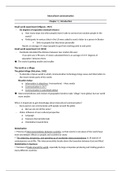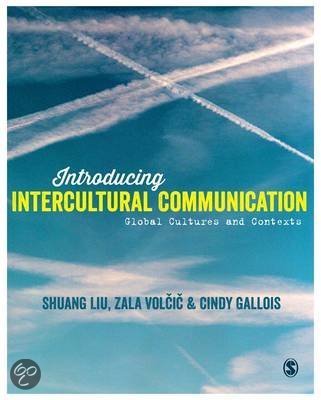Intercultural communication
Chapter 1 | Introduction
Small world experiment (Milgram, 1967)
- Six degrees of separation (network theory)
o How many steps (via other people) does it take to connect two random people in the
world?
o Participants in various cities in the US were asked to send a letter to a person in Boston
Only via people that they knew personally
Result: on average 5/5 steps (people) to get from starting point to end point
Small world experiment 2.0 (2012)
- Facebook calculated the distance between two random FB users
if you pick any 2 FB users, it’s been calculated there’s an average of 3.57 ‘degrees of
separation’ between them
The world is getting smaller and smaller
The world as a village:
The global village (McLuhan, 1962)
- To describe a future world in which communication technology brings news and information to
the most remote parts of the world.
Situation today:
o Information is ubiquitous (=everywhere) – Mass media
o Communication is 24/7
o Communication is potentially global
Interconnectedness and erosion of geographic borders make ‘village’ more global, but our world
more smaller
Why is it important to gain knowledge about intercultural communication?
- Every person can communicate with people around the globe
o But we are not all the same!
- Video: Influence of own cultural perspective
o Language
o Manners (formal/informal)
o Orientation towards time
Globalization
= ‘Process of interconnectedness between societies, so that events in one place of the world have
more and deeper effects on people and societies far away.’
= ‘The widening, deepening, and speeding up of worldwide interconnectedness in all aspects of
contemporary social life. This interconnectivity breaks down the boundary between East and West.’
Globalization in business
= ‘Increase of trade around the world, especially by large companies producing and trading goods in
many different countries.’
,= ‘The idea that the world is developing a single economy and culture as a result of improved
technology and communications and the influence of very large multinational companies.’
Globalization is a process by which geographic borders as boundaries between nations and states are
eroding.
Measurement of globalization:
- KOF Index of globalization
o Economic: trade & investment flows, import/export
o Social: personal contact, information flows, number of McDonalds restaurants, IKEA
stores, etc.
o Political: foreign embassies in a country, membership of international organizations, etc.
Views/perspectives of globalization:
1. Globalists: inevitable development, can’t be resisted or significantly influenced by human
intervention.
2. Traditionalists: most economic and social activity is regional, rather than global, significant
role of nation-states.
3. Transformationalists: significant shift, but there is still significant scope for national, local and
other agencies.
Conflict between globalists and sceptics:
Globalists: emphasize possibility of transnational media systems and communication technology to
create a global public sphere.
Sceptics: stress persistent national features of the news media, and the continuing stability of the
nation-state paradigm.
Contributors to cultural diversity:
1. Advanced technology and transportation, and increased mobility:
o Easier to travel (increasing mobility and technology) changes nature of society: makes
global village smaller, but more diverse
o Easier to interact (physically and e.g. through internet)
o Smaller, yet more diverse world
o Affect how we form relationships with others. Typically, social relationships were
circumscribed by how far one could walk social relationships transformed and expanded
challenge: understanding other cultures
However: strange increase in wall-building, in order to separate people. While changes in
technology have facilitated exchange of ideas, they also magnified possibility for
misunderstandings
2. Global economy and business transactions
o Global transformation= ‘worldwide economic and technological changes that influence
how people relate to one another’. Local market as diverse as global market (e.g.
everybody in the world can buy an iPhone)
o Cultural diversity shapes market demand and economic behaviours
o International expansion: MNC’s operating globally, outsourcing to low-wage countries
, o Diverse workforce/cross-cultural teams: migrant workers, expats allows organizations to
make use of scarce resources and thus increase their competitive advantage
Challenge: understanding cultural tensions in intercultural communication (e.g. BREXIT,
EU, NATO)
3. Mass migration and international exchange
o Immigration flow: from developing to developed countries
o Migrant workers who move to a host country temporarily
o Student exchanges
o Expats
- Increases cultural diversity for receiving countries, and contributes to social and economic
development in both countries
Challenge: how to promote intercultural understanding so as to reap the benefits of
cultural diversity and reduce intercultural tensions.
Ethnicity
(Smith, 2007):
- Myths and memories as part of a culture
- Every ethnic group mythologized version of its past:
o Heroic events (victories/glories, sacrifices/traumas)
o Heroes (actual historical figures and/or mythologized characters)
often evoked during different occasions and ceremonies to
inspire its members
Build social cohesion
Particularize their common identity
enhance sense of belonging and togetherness
Multi-ethnic environments provide not only constraints, but also opportunities. Ethnicity is important
for organizations at external (contextual) and internal (operational) levels.
Necessity and benefits of intercultural communication:
1. Multiculturalism (& diversity) = the composition of a society made up of diverse cultures
(descriptive level)
o ‘A society’s tolerance to diversity and acceptance of equal societal participation of diverse
groups’ attitude
Necessary to study intercultural communication. Maintenance of nationalism and continuity of
the mainstream culture have been key issues of concern in all countries that receive migrants.
migrants have long been forming associations to maintain their ethnic and cultural heritage and
promote survival of their languages within a host country’s mainstream institutions.
2. Building intercultural understanding: become aware of cultural rules by being confronted
with cultural rules (and laws) of others that are different. (e.g. imprisonment for insulting the
king)
- Understanding is the first step towards acceptance
3. Promoting international business exchange
, o Communicating with unfamiliar cultures does not simply mean finding a translator
o Understanding cultures and cultural differences is the key to successful business
exchange (e.g. Chinese believe non-economic factors, such as trust, may play bigger role
in influencing decision making)
4. Facilitating cross-cultural adaption
o Tension between immigrants and host nationals often centres on the extent to which
immigrants can maintain their heritage culture in host country – melting pot or salad
bowl?
Ethnocentrism = seeing own culture as the central and best one, and seeing other cultures as
insignificant or even inferior lead to prejudice, stereotypes, discrimination
foster ingroup survival, solidarity, conformity, loyalty, and cooperation
Cultural relativism = degree to which an individual judges another culture by its context. Try to
evaluate behaviours of a culture using that culture’s assumptions about reality.
To understand another culture, we need to communicate and broaden our understanding of its
practices and beliefs enhancing our cultural relativism
Intercultural knowledge
- Widens our vision to include an alternative perspective of valuing and relating
- By understanding beliefs, values, and worldviews, we can understand logic that motivates
actions/behaviours of others
- Cultural differences don’t prevent from communicating with each other, they enrich us through
communication.
- Culturally sensitive communication can increase relational closeness and deepen cultural self-
awareness
- Reduces anxiety and uncertainty communication process smoother and more successful
Competencies essential in global workplace:
1. Intercultural communication skills
2. Problem-solving ability
3. Global leadership
e.g. Malay employees emphasize values of family togetherness, harmony in relationships, and respect
for seniority vs. North American employees value individuality and personal achievement.
Chapter 2 | Understanding communication
Communication = ‘the process by which people use shared verbal or nonverbal codes, systems, and
media to exchange information in a particular cultural context.’ ability to share ideas and feelings
- Source/sender: someone who sends a message encoded in signs or symbols
- Receiver: who interprets the message by decoding the signs or symbols
Requires that all parties understand a common ‘language’ or code
Don’t need 2 persons for communication during:
- Intrapersonal communication / interpersonal dialogue.





